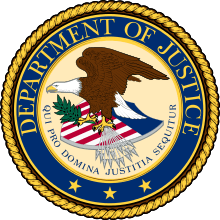Elena Kagan
| Elena Kagan | |
|---|---|
.jpg) | |
| Associate Justice of the Supreme Court of the United States | |
|
Assumed office August 7, 2010 | |
| Nominated by | Barack Obama |
| Preceded by | John Paul Stevens |
| 45th United States Solicitor General | |
|
In office March 19, 2009 – May 17, 2010 | |
| President | Barack Obama |
| Deputy | Neal Katyal |
| Preceded by | Edwin Kneedler (Acting) |
| Succeeded by | Neal Katyal (Acting) |
| 11th Dean of Harvard Law School | |
|
In office July 1, 2003 – March 19, 2009 | |
| Preceded by | Robert Clark |
| Succeeded by | Martha Minow |
| Personal details | |
| Born |
April 28, 1960 New York City, New York, U.S. |
| Political party | Democratic[1] |
| Alma mater |
Princeton University Worcester College, Oxford Harvard Law School |
| Religion | Judaism |
Elena Kagan (pronounced /ˈkeɪɡən/; born April 28, 1960)[2] is an Associate Justice of the Supreme Court of the United States. Kagan is the Court's 112th justice and fourth female justice.
Kagan was born and raised in New York City. After attending Princeton, Oxford, and Harvard Law School, she completed federal Court of Appeals and Supreme Court clerkships. She began her career as a professor at the University of Chicago Law School, leaving to serve as Associate White House Counsel, and later as policy adviser, under President Clinton. After a nomination to the United States Court of Appeals for the D.C. Circuit, which expired without action, she became a professor at Harvard Law School and was later named its first female dean.
In 2009, Kagan became the first female Solicitor General. On May 10, 2010, President Barack Obama nominated her to the Supreme Court to fill the vacancy arising from the impending retirement of Justice John Paul Stevens, and she resigned her position as Solicitor General in August 2010 upon her confirmation to the Supreme Court.[3] After confirmation, Kagan was sworn in on August 7, 2010, by Chief Justice John G. Roberts. Kagan's formal investiture ceremony before a special sitting of the United States Supreme Court took place on October 1, 2010.[4]
Personal life
Kagan was born in New York City, the middle of three children, on the city's Upper West Side. Her father, Robert Kagan, was an attorney, and her mother, Gloria (Gittelman) Kagan, taught at Hunter College Elementary School.[5][6] Kagan's two brothers are public school teachers.[7]
Kagan and her family lived in a third-floor apartment at West End Avenue and 75th Street[8] and attended Lincoln Square Synagogue.[9] Kagan was independent and strong-willed in her youth and, according to a former law partner, clashed with her Orthodox rabbi over aspects of her bat mitzvah.[8] "She had strong opinions about what a bat mitzvah should be like, which didn't parallel the wishes of the rabbi," said her former colleague. "But they finally worked it out. She negotiated with the rabbi and came to a conclusion that satisfied everybody." Kagan's rabbi, Shlomo Riskin, had never performed a ritual bat mitzvah before.[9] "Elena Kagan felt very strongly that there should be ritual bat mitzvah in the synagogue, no less important than the ritual bar mitzvah. This was really the first formal bat mitzvah we had," said Riskin. Kagan asked to read from the Torah on a Saturday morning but ultimately read on a Friday night, May 18, 1973, from the Book of Ruth.[9] Today, she identifies with Conservative Judaism.[9]
Childhood friend Margaret Raymond recalled that Kagan was a teenage smoker but not a partier. On Saturday nights, she and Kagan "were more apt to sit on the steps of the Metropolitan Museum of Art and talk."[8] Kagan also loved literature and re-read Jane Austen's Pride and Prejudice every year.[8] In her Hunter College High School yearbook of 1977, Kagan was pictured in a judge's robe and holding a gavel.[10] Next to her photo was a quote from former Supreme Court Justice Felix Frankfurter: "Government is itself an art, one of the subtlest of arts."[11]
Education
After graduating from high school, Kagan attended Princeton University, where she earned an A.B., summa cum laude in history in 1981. Among the subjects she studied was the socialist movement in New York City in the early 20th century. She wrote a senior thesis under historian Sean Wilentz titled "To the Final Conflict: Socialism in New York City, 1900–1933". In it she wrote, "Through its own internal feuding, then, the SP [Socialist Party] exhausted itself forever. The story is a sad but also a chastening one for those who, more than half a century after socialism's decline, still wish to change America."[12] Wilentz insists that she did not mean to defend socialism, noting that she "Was interested in it. To study something is not to endorse it."[13] Wilentz called Kagan "one of the foremost legal minds in the country, she is still the witty, engaging, down-to-earth person I proudly remember from her undergraduate days."[14]
As an undergraduate, Kagan also served as editorial chair of The Daily Princetonian. Along with eight other students (including Eliot Spitzer, who was student body president at the time), Kagan penned the Declaration of the Campaign for a Democratic University, which called for "a fundamental restructuring of university governance" and condemned Princeton's administration for making decisions "behind closed doors".[15]
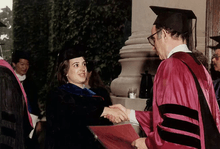
In 1980, Kagan received Princeton's Daniel M. Sachs Class of 1960 Graduating Scholarship,[16] one of the highest general awards conferred by the university, which enabled her to study at Worcester College, Oxford. She earned a Master of Philosophy in Politics at Oxford in 1983.[17] She received a Juris Doctor, magna cum laude, at Harvard Law School in 1986, where she was supervisory editor of the Harvard Law Review. Friend Jeffrey Toobin recalled that Kagan "stood out from the start as one with a formidable mind. She's good with people. At the time, the law school was a politically charged and divided place. She navigated the factions with ease, and won the respect of everyone."[18]
Early Career
Kagan was a law clerk for Judge Abner J. Mikva of the United States Court of Appeals for the District of Columbia Circuit in 1987 and for Justice Thurgood Marshall of the U.S. Supreme Court in 1988. Marshall nicknamed the 5 foot 3 inch Kagan "Shorty".[8] She later entered private practice as an associate at the Washington, D.C., law firm of Williams & Connolly.[2]
Kagan joined the faculty of the University of Chicago Law School as an assistant professor in 1991 and became a tenured professor of law in 1995.[19] While at the University of Chicago, she published a law review article on the regulation of First Amendment hate speech in the wake of the Supreme Court's ruling in R.A.V. v. City of St. Paul;[20] an article discussing the significance of governmental motive in regulating speech;[21] and a review of a book by Stephen L. Carter discussing the judicial confirmation process.[22] In the first article, which became highly influential, Kagan argued that the Supreme Court should examine governmental motives when deciding First Amendment cases,[23] and analyzed historic draft-card burning and flag burning cases in light of free speech arguments.[24]
According to her colleagues, Kagan's students complimented and admired her from the beginning, and she was granted tenure "despite the reservations of some colleagues who thought she had not published enough."[25]
White House and judicial nomination
Kagan served as Associate White House Counsel for United States President Bill Clinton from 1995–1996, beginning when her mentor Judge Mikva served as White House Counsel. From 1997–1999 she worked as Deputy Assistant to the President for Domestic Policy and Deputy Director of the Domestic Policy Council. Kagan worked on topics like budget appropriations, campaign finance reform, and social welfare issues. Her work is cataloged in the Clinton Library.[26] Kagan co-authored a 1997 memo urging Clinton to support a ban on late-term abortions: "We recommend that you endorse the Daschle amendment in order to sustain your credibility on HR 1122 and prevent Congress from overriding your veto."[27]
On June 17, 1999, Clinton nominated Kagan to the U.S. Court of Appeals for the District of Columbia Circuit, to replace James L. Buckley, who had taken senior status in 1996. The Senate Judiciary Committee's Republican Chairman Orrin Hatch scheduled no hearing, effectively ending her nomination. When Clinton's term ended, her nomination to the D.C. Circuit Court lapsed, as did the nomination of fellow Clinton nominee Allen Snyder.[28]
Return to academia
After her service in the White House and her lapsed judicial nomination, Kagan returned to academia in 1999. She initially sought to return to the University of Chicago Law School; however, she had given up her tenured position during her extended stint in the Clinton Administration. Thus, she needed to be rehired and the school chose not to do so, reportedly because of doubts about her commitment to academia.[29] Kagan quickly found a position as a visiting professor at Harvard Law School. While at Harvard, she authored a law review article on United States administrative law, including the role of aiding the President of the United States in formulating and influencing federal administrative and regulatory law, which was honored as the year's top scholarly article by the American Bar Association's Section on Administrative Law and Regulatory Practice, and is being developed into a book to be published by Harvard University Press.[30]
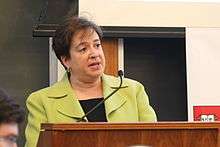
In 2001, she was named a full professor and in 2003 was named Dean of the Law School by Harvard University President Lawrence Summers.[31] She succeeded Robert C. Clark, who had served as dean for over a decade. The focus of her tenure was on improving student satisfaction. Efforts included constructing new facilities and reforming the first-year curriculum as well as aesthetic changes and creature comforts, such as free morning coffee. She has been credited for employing a consensus-building leadership style, which surmounted the school's previous ideological discord.[32][33][34]

In her capacity as dean, Kagan inherited a $400 million capital campaign, "Setting the Standard", in 2003. It ended in 2008 with a record breaking $476 million raised, 19% more than the original goal.[35] Kagan made a number of prominent new hires, increasing the size of the faculty considerably. Her coups included hiring legal scholar Cass Sunstein away from the University of Chicago[36] and Lawrence Lessig away from Stanford.[37] She also broke a logjam on conservative hires by bringing in scholars such as Jack Goldsmith, who had been serving in the Bush administration.[33]
According to Kevin Washburn, then-dean of the University of New Mexico School of Law, Kagan transformed Harvard Law School from a harsh environment for students to one that was much more student-centric.[38]
During her deanship, Kagan upheld a decades-old policy barring military recruiters from the Office of Career Services because she felt that the military's "Don't Ask, Don't Tell" policy discriminated against gays and lesbians. According to Campus Progress,
As dean, Kagan supported a lawsuit intended to overturn the Solomon Amendment so military recruiters might be banned from the grounds of schools like Harvard. When a federal appeals court ruled The Pentagon could not withhold funds, she banned the military from Harvard's campus once again. The case was challenged in the Supreme Court, which ruled the military could indeed require schools to allow recruiters if they wanted to receive federal money. Kagan, though she allowed the military back, simultaneously urged students to demonstrate against Don't Ask, Don't Tell.[39][40]
In October 2003, Kagan transmitted an e-mail to students and faculty deploring that military recruiters had shown up on campus in violation of the school's anti-discrimination policy. It read, "This action causes me deep distress. I abhor the military's discriminatory recruitment policy." She also wrote that it was "a profound wrong—a moral injustice of the first order."[41]
From 2005 through 2008, Kagan was a member of the Research Advisory Council of the Goldman Sachs Global Markets Institute and received a $10,000 stipend for her service in 2008.[42]
By early 2007, Kagan was a finalist for the presidency of Harvard University as a whole after Lawrence Summers' resignation the previous year, but lost out to Drew Gilpin Faust. She was reportedly disappointed not to be chosen, and supportive law school students threw her a party to express their appreciation for her leadership.[43]
Solicitor General
On January 5, 2009, President-elect Barack Obama announced he would nominate Kagan to be Solicitor General.[44][45] Before this appointment she had never argued a case before any court.[46] At least two previous solicitors general, Robert Bork and Kenneth Starr, also had no previous Supreme Court appearances, though Starr was a judge on the United States Court of Appeals for the District of Columbia Circuit before becoming Solicitor General.[47]
Kagan was confirmed by the U.S. Senate on March 19, 2009, by a vote of 61 to 31,[48] becoming the first woman to hold the position. She made her first appearance before the Supreme Court on September 9, 2009, in Citizens United v. Federal Election Commission.[49]
The First Amendment Center and the Cato Institute later expressed concern over arguments Kagan advanced as a part of her role as Solicitor General. For example, during her time as Solicitor General, Kagan prepared a brief defending a law later ruled unconstitutional that criminalized depictions of animal cruelty.[50][51] During her confirmation hearing, she said that "there is no federal constitutional right to same-sex marriage." Also during her confirmation hearing, she was asked about the Defense of Marriage Act, pursuant to which states were not required to recognize same-sex marriages originating in other states. Kagan indicated that she would defend the act "if there is any reasonable basis to do so".[52]
Supreme Court
Nomination

Prior to the election of President Barack Obama, Kagan was the subject of media speculation regarding her potential to be nominated to the Supreme Court of the United States if a Democratic president were elected in 2008.[53][54][55][56][57] This speculation increased after the retirement announcement of Associate Justice David H. Souter, effective at the start of the Court's summer 2009 recess.[58] Upon the death of Justice Antonin Scalia in 2016, CNN political commentator and former senior advisor to Obama David Axelrod reported that Scalia had personally recommended Kagan as an adequate replacement for Souter.[59]
It was speculated that her position as Solicitor General would increase Kagan's chances for nomination, since Solicitors General have been considered potential nominees to the Supreme Court in the past. On May 13, 2009, the Associated Press reported that Obama was considering Kagan, among others, for possible appointment to the United States Supreme Court.[60] On May 26, 2009, however, Obama announced that he was nominating Sonia Sotomayor to the post.[61]
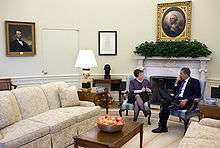
On April 9, 2010, Justice John Paul Stevens announced that he would retire at the start of the Court's summer 2010 recess, triggering new speculation about Kagan's potential nomination to the bench.[62] In a Fresh Dialogues interview, Jeffrey Toobin, a Supreme Court analyst and Kagan's friend and law school classmate,[63] speculated that Kagan would likely be President Obama's nominee, describing her as "very much an Obama type person, a moderate Democrat, a consensus builder."[64] This possibility alarmed many liberals and progressives, who worried that "replacing Stevens with Kagan risks moving the Court to the right, perhaps substantially to the right."[65]
While Kagan's name was mentioned as a possible replacement for Justice Stevens, the New York Times noted that she "has supported assertions of executive power."[66] This view of vast executive power has caused some commentators to fear that she would reverse the majority in favor of protecting civil liberties on the Supreme Court were she to replace Stevens.[67]
On May 10, 2010, Obama nominated Kagan to the Supreme Court to fill the vacancy left by Justice Stevens.[68] The deans of over one-third of the country's law schools, sixty-nine people in total, endorsed Kagan's nomination in an open letter in early June. It lauded what it considered her coalition-building skills and "understanding of both doctrine and policy" as well as her written record of legal analysis.[69]

The confirmation hearings began June 28. Kagan's testimony and her answers to the Senate Judiciary Committee's questions on July 20 were uneventful, containing no new revelations about her character or background. Arlen Specter of Pennsylvania cited an article Kagan had published in the Chicago Law Review in 1995, criticizing the evasiveness of Supreme Court nominees in their hearings.[70] Kagan, noted Specter, was now practicing that very evasiveness.[71] On July 20, 2010, the Senate Judiciary Committee voted 13–6 to recommend Kagan's confirmation to the full Senate. On August 5 the full Senate confirmed her nomination by a vote of 63–37.[72] The voting was largely on party lines, with five Republicans (Richard Lugar, Judd Gregg, Lindsey Graham, Susan Collins, and Olympia Snowe) supporting her and one Democrat (Ben Nelson) opposing. The Senate's two independents voted in favor of confirmation. She was sworn in by Chief Justice John Roberts on Saturday August 7, in a private ceremony.[4][73]
Kagan is the first justice appointed without any prior experience as a judge since William Rehnquist in 1972.[74][75][76] She is the fourth female justice in the Court's history (and, for the first time, part of a Court with three female justices) and the eighth Jewish justice,[77] making three of the eight current justices Jewish.
Tenure as Justice
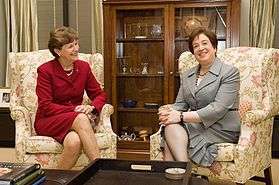
Kagan's first opinion, Ransom v. FIA Card Services, was filed on January 11, 2011. In an 8–1 decision, Kagan found that an individual declaring bankruptcy could not count expenses for a car he had paid off in his "applicable monthly expenses".[78][79]
Recognition
In 2013, a painting featuring Kagan, Sonia Sotomayor, Ruth Bader Ginsburg, and Sandra Day O'Connor was unveiled at the Smithsonian National Portrait Gallery in Washington, D.C. According to the Smithsonian at the time, the painting was on loan to the museum for three years.[80]
See also
- Barack Obama Supreme Court candidates
- Bill Clinton judicial appointment controversies
- Demographics of the Supreme Court of the United States
- List of law clerks of the Supreme Court of the United States
References
- ↑ "In Kagan, 'a Democrat's Democrat'". POLITICO.
- 1 2 Who's Who In America (2008). "Elena Kagan – WhosWhoInAmerica.Com". Marquis. Retrieved January 3, 2009.
- ↑ https://www.justice.gov/osg/bio/elena-kagan
- 1 2 Julie Hirschfeld Davis (August 5, 2010). "Senate Kagan sworn in as Supreme Court justice: She won't be formally installed as a justice until Oct. 1". Associated Press. Retrieved August 7, 2010.
- ↑ "Paid Notice: Deaths Kagan, Gloria Gittelman". The New York Times, July 13, 2008.
- ↑ "Robert Kagan, 67, Lawyer for Tenants". The New York Times, July 25, 1994.
- ↑ "Kagan's remarks on her Supreme Court nomination". Associated Press, May 10, 2010.
- 1 2 3 4 5 Sheryl Gay Stolberg, Katharine Q. Seelye, Lisa W. Foderaro (May 10, 2010). "A Climb Marked by Confidence and Canniness". The New York Times. Retrieved May 15, 2010.
- 1 2 3 4 "Growing Up, Kagan Tested Boundaries of Her Faith." The New York Times. May 12 2010. May 19 2010.
- ↑ "Pals from student days remember a determined Elena Kagan". CNN. May 11, 2010. Retrieved May 22, 2010.
- ↑ "Manhattan Renders Its Verdict on Court Pick". Fordham Law Newsroom. May 11, 2010. Retrieved June 10, 2011.
- ↑ Brad DeLong (May 17, 2010). "Elena Kagan's Undergraduate Thesis – Grasping Reality with Both Hands". Delong.typepad.com. Retrieved July 1, 2010.
- ↑ Seelye, Katharine Q; Lisa W. Foderaro; Sheryl Gay Stolberg (May 10, 2010). "A Climb Marked by Confidence and Canniness". The New York Times. Retrieved May 10, 2010.
- ↑ Cliatt, Cass (May 10, 2010). "Princeton alumna Kagan nominated to Supreme Court". Princeton University. Retrieved May 10, 2010.
- ↑ Romano, Andrew (May 19, 2010). "Elena Kagan: Cub Reporter". Newsweek. Retrieved May 19, 2010.
- ↑ Fellowship in memory of Rhodes Scholar from Princeton, Daniel M. Sachs. See http://www.princeton.edu/oip/fellowships/major-awards/sachs/ http://dwkcommentaries.com/tag/rhodes-scholarship/ Other notable Sachs Scholars include Anne-Marie Slaughter and Christine Whelan.
- ↑ "Kagan '81 nominated for U.S. solicitor general", Daily Princetonian, December 12, 2008.
- ↑ "Elena Kagan's Nomination". The New Yorker. May 10, 2010. Retrieved May 15, 2010.
- ↑ Sweet, Lynn (November 20, 2007). "Elena Kagan played Chicago-style 16-inch softball at U of Chicago". Chicago Sun Times Blogs. Retrieved May 11, 2010.
- ↑ The Changing Face of First Amendment Neutrality: R.A.V. v. St. Paul, Rust v. Sullivan and the Problem of Content-Based Underinclusion, The Supreme Court Review, Vol. 1992 pp. 29-77 (1992)
- ↑ Private Speech, Public Purpose: The Role of Governmental Motive in First Amendment Doctrine, 63 U.Chicago L.Rev. Vol.63, No.2 (Spring 1996) pp. 413-517
- ↑ Review of The Confirmation Mess, U.Chicago L.Rev. Vol. 62 (Spring 1995) pp. 919-942
- ↑ "Kagan Argued for Government 'Redistribution of Speech'". CNSNews.com. Retrieved May 13, 2010.
- ↑ http://www.scotusblog.com/wp-content/uploads/2010/03/Private-Speech-Public-Purpose.pdf
- ↑ Seelye, Katharine Q; Lisa W. Foderaro; Sheryl Gay Stolberg (May 10, 2010). "A Climb Marked by Confidence and Canniness". The New York Times. Retrieved May 10, 2010.
- ↑ Main page, Elena Kagan Collection, Clinton Library, accessed July 22, 2013.
- ↑ Jill Zeman Bleed, Kagan in '97 urged Clinton to ban late abortions, MSNBC (May 10, 2010).
- ↑ Savage, David G. (September 27, 2002). "Little Light Shed on Bush Judicial Pick". Los Angeles Times. p. A-18. Retrieved January 5, 2009.
The post Estrada hopes to fill is vacant because Republicans blocked action on two Clinton picks for the court: Washington attorney Allen Snyder and Harvard law professor Elena Kagan.
- ↑ Sweet, Lynn (May 11, 2010). "Kagan's Chicago ties :: Chicago Sun-Times :: 44: Barack Obama". Chicago Sun-Times. Retrieved July 1, 2010.
- ↑ "Elena Kagan law articles not so easy to count". @politifact.
- ↑ Berman, Russell (August 21, 2008). "Summers Manages Low Profile While Advising Senator Obama; Some Women Warn Democrat About Former Harvard President". New York Sun. Retrieved January 5, 2009.
- ↑ Saltzman, Jonathan; Jan, Tracy (April 15, 2010). "At Harvard, dean eased faculty strife". Boston Globe. Retrieved May 13, 2010.
- 1 2 Woolhouse, Megan (January 4, 2009). "Kagan, possible Obama pick, thawed Harvard Law". Boston Globe. Retrieved May 13, 2010.
- ↑ "Elena Kagan and the Miracle at Harvard". Social Science Research Network. June 28, 2010. Retrieved June 30, 2010.
- ↑ "Harvard Law School Celebrates Record-setting Capital Campaign". Harvard Law School. October 2008. Retrieved January 5, 2009.
Harvard Law School's "Setting the Standard" campaign has raised $476,475,707, making it the most successful fund-raising drive in the history of legal education.
- ↑ Woolhouse, Megan (January 4, 2009). "She's thawed Harvard Law". Boston Globe. Retrieved May 10, 2010.
- ↑ "The Harvard Law Record – Lessig rejoining faculty". Hlrecord.org. Retrieved May 13, 2010.
- ↑ Washburn, Kevin K. (July 26, 2010). "Elena Kagan and the Miracle at Harvard". University of New Mexico School of Law Legal Studies Research Paper Series. SSRN. Retrieved November 13, 2011.
- ↑ Matthews, Dylan (May 5, 2009). "A More Gay Friendly Supreme Court". Campus Progress. Retrieved April 16, 2010.
- ↑ Totenberg, Nina (December 22, 2009). "Solicitor General Kagan Holds Views Close To Her Chest". NPR. Retrieved December 22, 2009.
- ↑ Goldstein, Amy (April 18, 2010). "Foes may target Kagan's stance on military recruitment at Harvard". The Washington Post. Retrieved May 1, 2010.
- ↑ Kelley, Matt (April 27, 2010). "Possible Supreme Court pick had ties with Goldman Sachs". USA Today. Retrieved May 10, 2010.
- ↑ Gay Stolberg, Sheryl (May 25, 2010). "At Harvard, Kagan Aimed Sights Higher". The New York Times. Retrieved February 11, 2012.
- ↑ "More Obama Justice Dept Picks Announced". CNN. January 5, 2009. Retrieved May 8, 2009.
- ↑ "Obama names Jewish woman as solicitor general". JTA. January 6, 2009. Retrieved July 1, 2010.
- ↑ Totenberg, Nina (May 9, 2010), Seen As Rising Star, Kagan Has Limited Paper Trail, NPR, retrieved August 5, 2010
- ↑ Healey, Jon (March 26, 2009). "Elena Kagan and the GOP's perilous partisanship". Los Angeles Times. Retrieved May 8, 2009.
- ↑ "On the Nomination (Confirmation Elena Kagan, of Massachusetts, to be Solicitor General)". United States Senate. March 19, 2009. Retrieved March 19, 2009.
- ↑ Mauro, Tony (September 9, 2009). "Supreme Court Majority Critical of Campaign Law Precedents". The Blog of LegalTimes. Retrieved November 28, 2009.
- ↑ David L. Hudson, Jr. (May 10, 2010). "Kagan's First Amendment record causes concern". First Amendment Center.
- ↑ Ilya Shapiro (May 10, 2010). "Initial Kagan Critiques Miss the (First Amendment) Point". Cato Institute.
- ↑ Lee, Carol E. (May 12, 2010). "Gay rights central to Elena Kagan fight". Politico.
- ↑ "As Harvard Seeks a President, Dean Kagan's Star Is Rising – March 10, 2006 – The New York Sun". Nysun.com. March 10, 2006. Retrieved May 8, 2009.
- ↑ McGough, Michael (August 9, 2004). "Campaign 2004: Election likely to alter make-up of Supreme Court". Post-gazette.com. Retrieved May 8, 2009.
- ↑ "The Democratic (Not So) Short List". SCOTUSblog. July 12, 2007. Archived from the original on December 12, 2007. Retrieved May 8, 2009.
- ↑ "Follow-Up to the Democratic (Not So) Short List". SCOTUSblog. Archived from the original on December 12, 2007. Retrieved May 8, 2009.
- ↑ "Dems sketch Obama staff, Cabinet – Mike Allen". Politico.com. Retrieved May 8, 2009.
- ↑ Souter, David H. (May 1, 2009). "David H. Souter Letter to President Obama, May 1, 2009" (PDF). The New York Times.
- ↑ Axelrod, David. "David Axelrod: A surprise request from Justice Scalia – CNN.com". CNN. Retrieved 2016-02-16.
- ↑ "AP source: Obama has more than 6 people for court". Retrieved May 13, 2009.
- ↑ Totenberg, Nina (April 30, 2009). "Supreme Court Justice Souter to Retire". NPR. Retrieved April 30, 2009.
- ↑ "Justice Stevens Says He Is Retiring This Summer". The New York Times. April 9, 2010. Retrieved April 9, 2010.
- ↑ Rothstein, Betsy (May 10, 2010) NBC Breaks Kagan News When Toobin Could Have Called, Mediabistro.com
- ↑ Fresh Dialogues Interview Series with Alison van Diggelen on YouTube, April 9, 2010.
- ↑ Glenn Greenwald (April 13, 2010) The case against Elena Kagan, Salon
- ↑ Possible Candidates, The New York Times (April 9, 2010)
- ↑ Glenn Greenwald, Justice Stevens' retirement and Elena Kagan, Salon (April 9, 2010)
- ↑ "Elena Kagan Nominated to the Supreme Court". CBS News. May 10, 2010. Retrieved March 30, 2012.
- ↑ Goldstein, Amy (June 15, 2010). "69 law school deans endorse Kagan in letter to Senate". The Washington Post. Retrieved July 1, 2010.
- ↑ "Elena Kagan's law review article said Supreme Court nominees should be forthcoming". PolitiFact. Retrieved May 4, 2011.
- ↑ Jay Newton-Small (June 30, 2010). "Kagan's Haven?". Time.
- ↑ Arce, Dwyer (August 5, 2010). "Senate votes to confirm Kagan to Supreme Court". JURIST. Retrieved December 15, 2010.
- ↑ Mark Arsenault (August 5, 2010). "Senate confirms Kagan as 112th justice to Supreme Court". Boston Globe. Retrieved August 5, 2010.
- ↑ Baker, Peter (May 2, 2010). "Obama Is Said to Choose Elena Kagan for the Supreme Court". The New York Times. Retrieved May 11, 2010.
- ↑ "Obama picks Kagan for Supreme Court – Supreme Court". MSNBC. Associated Press. May 11, 2010. Retrieved May 11, 2010.
- ↑ "Supreme Court: Justices Without Prior Judicial Experience". FindLaw.com. Retrieved May 11, 2010.
- ↑ Scherer, Michael (May 10, 2010). "Court Nominee Elena Kagan: Let the Scrutiny Start". Time. Retrieved October 3, 2010.
- ↑ Bravin, Jess (January 11, 2011). "Justice Kagan Pens First Opinion, an 8–1 Win for Credit Card Companies". The Wall Street Journal. Retrieved January 18, 2011.
- ↑ "09-907 Ransom v. FIA Card Services (01/11/2011)" (PDF). Retrieved May 4, 2011.
- ↑ Reilly, Mollie (October 28, 2013). "The Women Of The Supreme Court Now Have The Badass Portrait They Deserve". The Huffington Post. Retrieved November 2, 2015.
External links
- Elena Kagan at the Biographical Directory of Federal Judges, a public domain publication of the Federal Judicial Center.

- Elena Kagan at Ballotpedia
- Issue positions and quotes at OnTheIssues
- Elena Kagan Through the Years – slideshow by ABC News
- Appearances on C-SPAN
| Academic offices | ||
|---|---|---|
| Preceded by Robert Clark |
Dean of Harvard Law School 2003–2009 |
Succeeded by Martha Minow |
| Legal offices | ||
| Preceded by Edwin Kneedler Acting |
United States Solicitor General 2009–2010 |
Succeeded by Neal Katyal Acting |
| Preceded by John Paul Stevens |
Associate Justice of the Supreme Court of the United States 2010–present |
Incumbent |
| United States order of precedence (ceremonial) | ||
| Preceded by Sonia Sotomayor as Associate Justice of the Supreme Court |
Order of Precedence of the United States as Associate Justice of the Supreme Court |
Succeeded by Senior Chief Justices of the Supreme Court None living |
| Succeeded by Otherwise John Paul Stevens as Senior Associate Justice of the Supreme Court | ||
| | |||||||||
|---|---|---|---|---|---|---|---|---|---|
|
 | ||||||||
